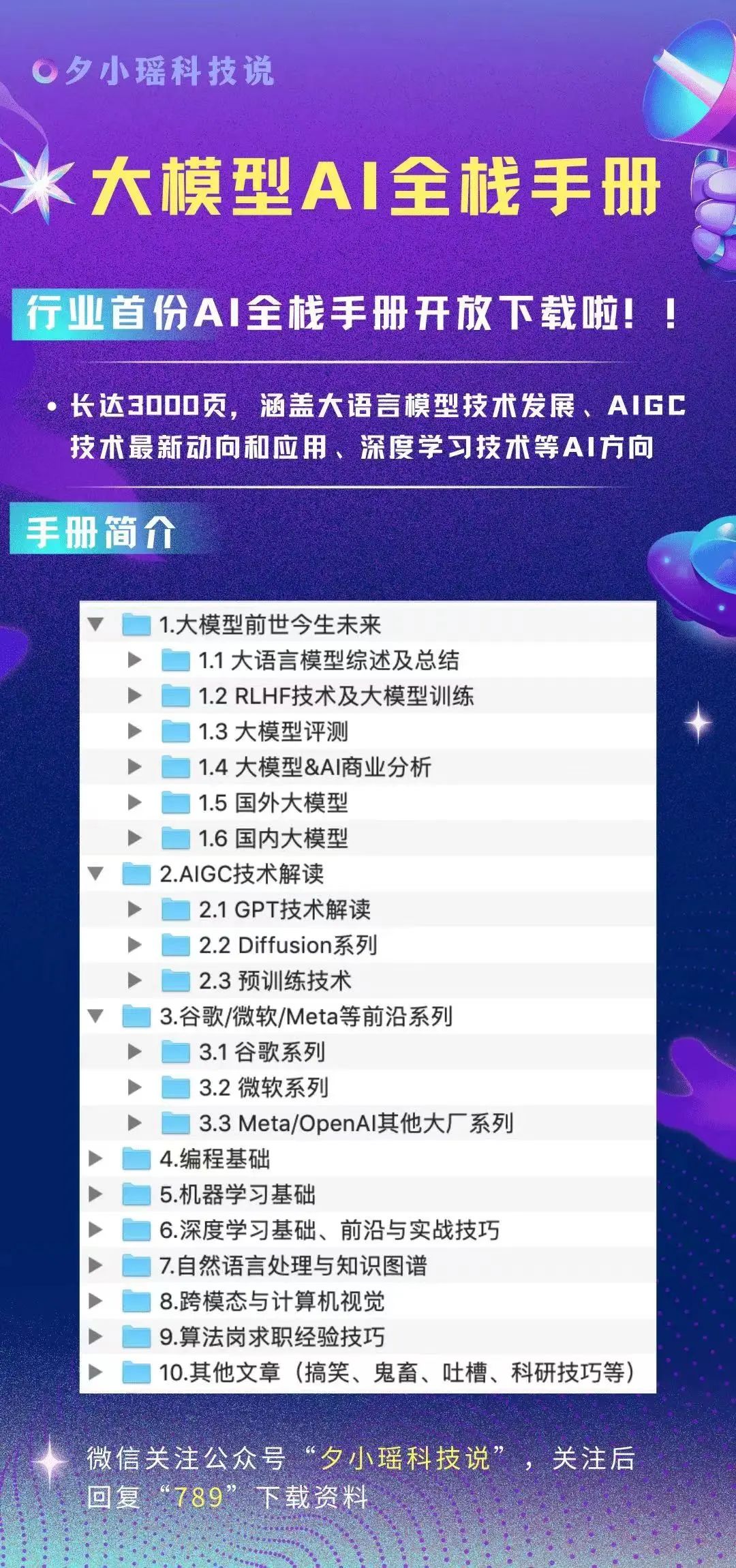1.包装类
| 基本类型 | 包装类 |
| boolean | Boolean |
| char | Character |
| byte | Byte |
| int | Integer |
| long | Long |
| float | Float |
| double | Double |
| short | Short |
从byte开始的包装类都是继承的Number,然后Number继承的object
从byte上面的都是直接继承的oblect
(1).装箱和拆箱
装箱:基本类型-->包装类型(valueof)
拆箱:包装类型-->基本类型(intvalue)
public class wrapper {
//手动装箱int-->Integer
int n1=10;
Integer integer1=Integer.valueOf(n1);
//手动拆箱Inreger-->int
Integer intege2=new Integer(20);
int n2=integer.intValue();
//现在都是自动的装箱拆箱
//自动装箱
int n3=100;
Integer integer3=n3;//调用了valueOf方法
//自动拆箱
int n4=integer3;//调用了intvalue方法
}(2). 包装类(Integer)-->String,String-->包装类(Integer)
包装类-->String
Integer i=10;//自动装箱
//方式1:
String s1=i+"";
//方式2:
String s2=i.toString();
//Integer里的tostring方法返回值String类型
//方式3:
String s3=String.valueOf(i);
//如果不理解可以ctrl+鼠标点击查看源码,valof方法调用了tostring方法,返回值都是String类型的String-->包装类
String s4="123";
Integer i2=Integer.parseInt(s4);//自动装箱
Integer i3=new Integer(s4);//Integer有一个这样的构造器(3).常用方法
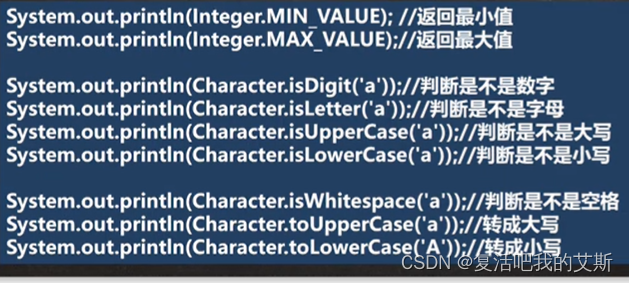
2.String
1.基本介绍
(1).String对象用于保存字符串,使用双引号括起来
String s1="abc";
String s2="3211";(2).字符串的字符使用unicode编码,一个字符(不区分字母汉字)占2个字节。1字节=8bit
(3).String类常用的构造器
//String s3=new String();
//String s4=new String(String original);
//String s5=new String(char[] a);
//String s6=new String(char[] a,int startindex,int count);(4).String 类实现了接口 Serializable[string 可以串行化:可以在网络传输]
接口 Comparable [string 对象可以比较大小]
(5).String 是final类,不能被其他的类继承
(6).String 有属性 private final char value[ ];用于存放字符串内容
一定要注意: value 是一个final类型,不可以修改(内容可以修改,内存地址不能修改)
final char value[]={'a','b','c'};
value[0]='1';//可以修改值
final char v2[]={'1','2','3'};
v2=value;//不能修改地址2.创建剖析
两种创建String对象的区别:
方式一:直接赋值String s1="qwq''
方式二:调用构造器String s2=new String(''qwq'');
方式一: 先从常量池查看是否有“qwq”数据空间,如果有,直接指向;如果没有则重新创建,然后指向。s1最终指向的是常量池的空间地址。
方式二:先在堆中创建空间,里面维护了value属性,指向常量池的qwq空间,如果常量池没有”qwq”,重新创建,如果有,直接通过value指向。s2最终指向的是堆中的空间地址。
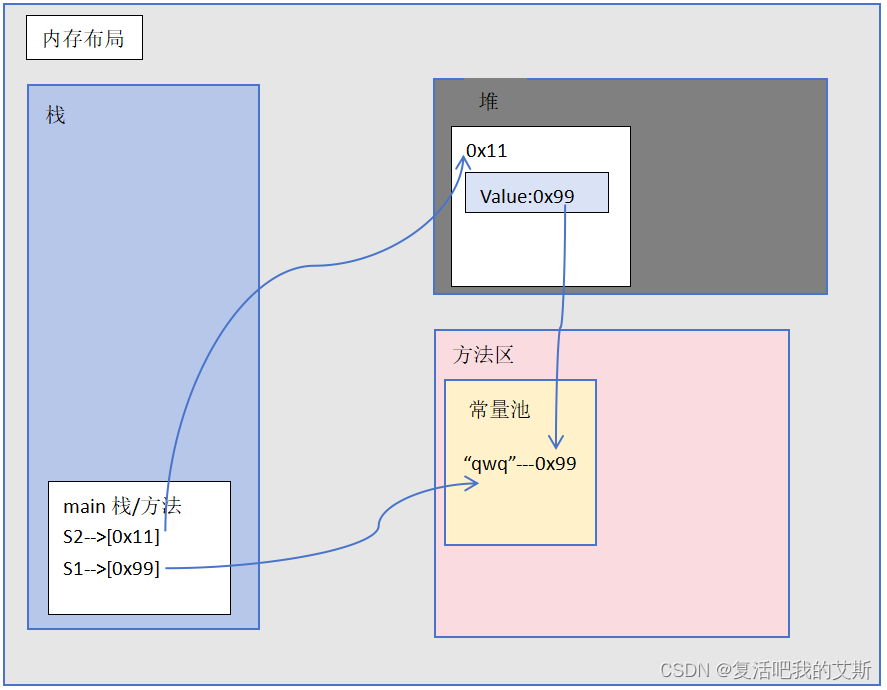
3.string常用方法
equals // 区分大小写,判断内容是否相等
equalslgnoreCase //忽略大小写的判断内容是否相等
length // 获取字符的个数,字符串的长度
indexof //获取字符在字符串中第1次出现的索引,索引从0开始,如果找不到,返回-1
lastIndexof //获取字符在字符串中最后1次出现的索引,索引从0开始,如找不到,返回-1
substring //截取指定范围的子串
trim //去前后空格
charAt:获取某索引处的字符,注意不能使用Str[index] 这种方式
public class ff {
public static void main(String[] args) {
//1.str1.equals(str2)
//2.
String s1="He";
String s2="he";
System.out.println(s1.equalsIgnoreCase(s2));//true
//3.
System.out.println("qwq".length());//3
//4.indexof('x')x第一次出现的位置,从0开始,找不到返回-1
//indexof("xq")还可以是字符串
String s3="xqwqxw";
System.out.println(s3.indexOf('x'));//0
System.out.println(s3.indexOf("xq"));
//5.lastIndex('w')
//lastindexof("xw")
System.out.println(s3.lastIndexOf('w'));//5
System.out.println(s3.lastIndexOf("xw"));//4
//6.subString(4)从4开始截取后面的,包括4【】
//subString(0,5)截取0-5,不包括5【)
//substring(2,5)[)
System.out.println(s3.substring(4));//xw
System.out.println(s3.substring(0,3));//xqw
System.out.println(s3.substring(2,5));//wqx
}
}public class ff2 {
public static void main(String[] args) {
String s="hello";
//1.toUpperCase()输出大写
System.out.println(s.toUpperCase());
//2.toLowerCase()输出小写
String s2="ASD";
System.out.println(s.toLowerCase());
//3.concat拼接字符串
String s3="qwq";
System.out.println(s.concat(s2).concat(s3));
//4.replace("a","b")a替换为b
String s4="汪汪喵喵咩咩";
System.out.println(s4.replace("汪汪","喵喵"));
//原来的s4不受影响
System.out.println(s4);//还是 汪汪喵喵咩咩
//5.split("x")以x为标准进行分割,返回一个数组,特殊字符要加转义符\
//\\\\等于\\,一个\配一个\
String s5="1,2,3,4455";
String ss1[]=s5.split(",");
for (int i = 0; i < ss1.length; i++) {
System.out.println(ss1[i]);
}
String s6="C:\\a\\b";
String ss2[]=s6.split("\\\\");//用\\分割
for (int i = 0; i < ss1.length; i++) {
System.out.println(ss1[i]);
}
//6.toCharArrY()把字符串转为字符数组
char cc1[]=s6.toCharArray();
for (int i = 0; i < cc1.length; i++) {
System.out.println(cc1[i]);
}
//7.compareTo()字符串比较
//每个字母一一比较,返回前面减后面的askm值
String s7="asd";
String s8="aaf";
System.out.println(s7.compareTo(s8));//s-a的ascm=18
String s9="asdf";
String s10="aafff";
System.out.println(s9.compareTo(s10));//18=s-a
//
} format占位符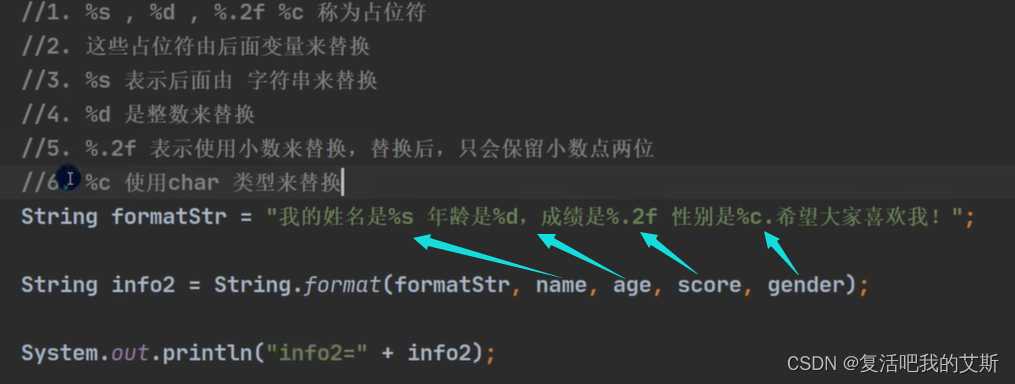
3.StringBuffer
1.基本介绍
(1).StringBuffer是final类,不能被继承
(2).他实现了Serializable接口,可以保存到文件,或网络传输
(3).继承了抽象类AbstractStringBuilder
(4).AbstractStringBuilder有属性char[ ]value,存放字符序列,保存在堆中
(5).有缓冲机制,增加或删除不用每次都改堆中的地址,除非放不下了,会开辟更大的地址空间,效率比string高。
2.构造方法
public class a {
public static void main(String[] args) {
//常用的构造方法
//1.创建一个大小为16的char[],用来存放字符内容
StringBuffer stringBuffer = new StringBuffer();
//2.创建一个指定大小的char[],100
StringBuffer stringBuffer1 = new StringBuffer(100);
//3.创建一个大小为"123''+16的char[]
StringBuffer stringBuffer2 = new StringBuffer("123");
}
}3.String和StringBuffer转换
String-->StringBuffer
StringBuffer-->String
public class b {
public static void main(String[] args) {
//S--->SB
//1.使用StringBuffeer构造器
String s1="qwq hi";
StringBuffer sb1 = new StringBuffer(s1);
//2.使用append方法
StringBuffer sb2 = new StringBuffer();
sb2=sb2.append(s1);
//SB-->S
//1.使用string构造器
StringBuffer sb3 = new StringBuffer("你好");
String s3 = new String(sb3);
//2.使用tostring()
String s4 = new String();
s4=sb3.toString();
}
}4.常用方法
append添加
delete删除
replace修改(替换)
indexof(查找第一次出现的位置)
insert(在指定位置插入,原来的内容后移)
public class c {
public static void main(String[] args) {
StringBuffer sb1 = new StringBuffer("qwq");
//增
sb1.append(",1");
sb1.append("2");
sb1.append("34567");
System.out.println(sb1);//qwq,123456
//删:删除索引[3,4)
System.out.println(sb1.delete(3,4));//qwq123456
//改(替换):[3,4)
System.out.println(sb1.replace(3,4,"aa"));//qwqaa23456
//查:查找字符串第一次出现的位置
System.out.println(sb1.indexOf("a"));//3
//插:在3的位置插入a
System.out.println(sb1.insert(3,"b"));//qwqbaa23456
}
}4.StringBuilder
1.基本介绍
(1).一般用在单线程,是stringBuffer的简易替换
(2).继承了abstractStringBulider类,实现了Serializable接口,可以保存到文件,或网络传输
(3).StringBuilder是final类,不能被继承
(4).有属性char[ ]value,存放字符序列,保存在堆中
2.方法
append
insert
和stringBuffer一样
5.String,sBuffer,Sbuilder三者的比较
String: 不可变字符序列,效率低,但是复用率高
StringBuffer: 可变字符序列、效率较高(增删)、线程安全
StringBuilder: 可变字符序列、效率最高、单个线程使用,线程不安全
对字符串做大量修改,不要使用String
结论:
1.如果字符串存在大量的修改操作,一般使用 StringBuffer 或StringBuilder
2.如果字符串存在大量的修改操作,并在单线程的情况,使用StringBuilder
3.如果字符串存在大量的修改操作,并在多线程的情况,使用StringBuffer
4.如果我们字符串很少修改,被多个对象引用,使用String,比如配置信息等
StringBuilder 的方法使用和 StringBuffer 一样
6.Math
public class mathMethod {
public static void main(String[] args) {
//1.绝对值abs
System.out.println(Math.abs(-10));//10
//2.幂pow
System.out.println(Math.pow(2,3));//8.0
//3.向上取整ceil
System.out.println(Math.ceil(10.34));//11.0
//4.向下取整floor
System.out.println(Math.floor(-3.11));//-3.0
//5.四舍五入round
System.out.println(Math.round(-88.1));//-88
System.out.println(Math.round(-88.9));//-89
//6.开根号sqrt
System.out.println(Math.sqrt(16));//4.0
System.out.println(Math.sqrt(-16));//NaN
//7.[0,1)的随机数random
//生成[2,7]的随机整数
System.out.println((int)(2+Math.random()*(7-2+1)));
//8.max,min
System.out.println(Math.max(1,2));//2
System.out.println(Math.min(22,0));//0
}
}7.Arrays类
常用方法
public class a {
public static void main(String[] args) {
Integer integer[]= {1,2,3,4,5};
//1.tostring方法显示数组
System.out.println(Arrays.toString(integer));
//2.sort排序
Integer arr[]= {11,2,3,44,-5};
//默认排序
Arrays.sort(arr);
System.out.println(Arrays.toString(arr));//从小到大
//定制排序
//有2个参数,1个要排序的数组,1个匿名内部类,实现compare方法
Arrays.sort(arr, new Comparator() {
@Override
public int compare(Object o1, Object o2) {
Integer i1=(Integer) o1;
Integer i2=(Integer) o2;
return i2-i1;
//返回的大于0从大到小,小于0是从小到大
}
});
}
}public class b {
public static void main(String[] args) {
//1.二叉查找,数组要有序的
int[]arr={1,2,90,123,567};
int index=Arrays.binarySearch(arr,1);//寻找'1',返回索引值0
//如果不存在,返回-(low+1) low是如果存在它应该在的位置的索引
System.out.println(index);
//2.copyOf 数组元素的复制
//从arr数组中复制arr.length个元素到newArr数组中
int []newArr=Arrays.copyOf(arr,arr.length);
System.out.println(Arrays.toString(newArr));
//3.fill数组元素的填充
Integer []num={1,2,3,4};
Arrays.fill(num,9);
System.out.println(Arrays.toString(num));
//4.equals比较2个数组中的元素是否一样
//num数组被替换为9了都
Integer []num1={9,9,9,9};
System.out.println(Arrays.equals(num1,num));
//5.asList把(2,3,4.5)数据转为一个list集合
List asList=Arrays.asList(2,3,4,5);
System.out.println(asList);//{2,3,4,5}
//返回的asList编译类型List(接口)
//运行类型java.util.Arrays#ArrayList,Arrays类的静态内部类
}
}8.BigInteger和BigDecimal
(1).BigInteger
//当我们编程中,需要处理很大的整数,Long 不够用
//可以使用BigInteger的类来搞定
public class a {
public static void main(String[] args) {
BigInteger bigInteger = new BigInteger("2333333333");
BigInteger bigInteger1 = new BigInteger("2333");
System.out.println(bigInteger);
//1,在对 BigInteger 进行加减乘除的时候,需要使用对应的方法,不能直接进行 + -
//2.add加法
BigInteger add = bigInteger.add(bigInteger1);
System.out.println(add);
//3.subtract-(减法) multipy*(乘法) divide/(除)和上面一样
}
}(2).BigDecimal
Decimal小数
//当我们需要保存一个精度很高的小数时,double 不够用
//可以是 BigDecimal
public class a {
public static void main(String[] args) {
double d=1.222222222222222222222222222333333333333d;
System.out.println(d);//精度被缩减
//当我们需要保存精度很高的数时,使用BigDecimal
BigDecimal b1=new BigDecimal("1.222222222222222222222222222333333333333");
BigDecimal b2=new BigDecimal("1.1");
System.out.println(b1);
//如果对BigDecimal进行加减乘除,要使用对应方法
System.out.println(b1.add(b2));
System.out.println(b1.subtract(b2));
System.out.println(b1.multiply(b2));
System.out.println(b1.divide(b2,BigDecimal.ROUND_CEILING));//可能抛出异常ArithmeticException,无限循环小数
//在调用divide方法时,指定精度即可BigDecimal.ROUND_CEILING
//保留分子的精度,分子是12位,结果保留12位
}
}9.日期类
(1).Data(第一代)
package com.qhx.date;
import java.text.ParseException;
import java.text.SimpleDateFormat;
import java.util.Date;
import java.util.SimpleTimeZone;
/**
* @author qhx
* @version 1.0
*/
public class datae01 {
public static void main(String[] args) throws ParseException {
//这里的Data是util包里的
Date d1=new Date();//获取当前系统时间
System.out.println("当前日期="+d1);
//输出当前日期=Fri Jul 26 10:40:58 CST 2024
//默认输出日期是国外的,因此通常需要对格式进行转换
//格式转换
//把Date格式化
//创建SimpleDateFormat对象,可以指定相应的格式
//这里的格式使用的是指定字母
SimpleDateFormat sdf=new SimpleDateFormat("yyyy年MM月dd日 hh:mm:ss E");
String format=sdf.format(d1);
System.out.println("当前日期"+format);
//当前日期2024年07月26日 03:50:12 星期五
//把一个格式化的String 转为对应的Date
String s="2024年02月10日 10:22:20 星期一";//要和上面sdf的格式一致
Date p=sdf.parse(s);
System.out.println("当前日期"+p);//Date格式
System.out.println(sdf.format(p));//字符串格式
//(2).
//通过指定毫秒数得到时间
Date d2=new Date(9234567);
System.out.println("d2毫秒数对应的时间"+d2);
//获取时间对应的毫秒数
System.out.println("d1对应的毫秒数"+d1.getTime());
}
}(2).Calendar(第二代)
package com.qhx.date;
import java.util.Calendar;
public class calendar01 {
public static void main(String[] args) {
//1.Calendar是一个抽象类, 并且构造器是private
//2.可以通过 getInstance() 来获取实例
//3.提供大量的方法和字段提供给程序员
Calendar c = Calendar.getInstance(); //创建日历类对象//比较简单,自由
System .out.println(c);
//获取日历对象的某个日历字段
//通过get方法获取
System.out.println("年:"+ c.get(Calendar.YEAR));
System.out.println("月:"+ c.get(Calendar.MONTH));
System.out.println("日:"+ c.get(Calendar.DAY_OF_MONTH));
System.out.println("时:"+ c.get(Calendar.HOUR));
System.out.println("分:"+ c.get(Calendar.MINUTE));
System.out.println("秒:"+ c.get(Calendar.SECOND));
//根据需求组合
System.out.println(c.get(Calendar.YEAR)+"年"+c.get(Calendar.MONTH)+"月"+c.get(Calendar.DAY_OF_MONTH)+"日");
}
}(3).localDate(日期+时间),localTime(时间),localDateTime(日期)(第三代)
package com.qhx.date;
import java.time.LocalDateTime;
import java.time.format.DateTimeFormatter;
public class LocalDate01 {
public static void main(String[] args) {
//使用now()返回当前日期时间
LocalDateTime ldt=LocalDateTime.now();//localTime.now()//localDateTime()
System.out.println(ldt);
System.out.println("年=" + ldt.getYear());
System.out.println("月="+ ldt.getMonth());//英文
System.out.println("月=" + ldt.getMonthValue());//数字
System.out.println("日=" + ldt.getDayOfMonth());
System.out.println("时=" + ldt.getHour());
System.out.println("分=" + ldt.getMinute());
System.out.println("秒=" + ldt.getSecond());
//格式化日期DateTimeFormatter类
DateTimeFormatter dateTimeFormatter=DateTimeFormatter.ofPattern("yyyy-MM-ddd HH:mm:ss");
String format=dateTimeFormatter.format(ldt);
System.out.println("格式化的日期类"+format);
//通过plus和minus方法对当前日期加或减
LocalDateTime localDateTime=ldt.plusDays(80);
//ldt加80天后是多会
System.out.println("80天后"+dateTimeFormatter.format(localDateTime));
//ldt122分钟前是多会
LocalDateTime localDateTime1=ldt.minusMinutes(122);
System.out.println(dateTimeFormatter.format(localDateTime1));
}
}
(4).instant时间戳
public class instans01 {
public static void main(String[] args) {
//1.通过 静态方法 now() 获取表示当前时间戳的对象
Instant now = Instant.now() ;
System.out.println(now);
//2。通过 from 可以把 Instant转成 Date
Date date = Date.from(now);
//3。通过 date的toInstant() 可以把 date 转成Instal
Instant instant = date .toInstant() ;
}
}7.练习
(1).
//下面的代码是否正确,为什么?
//Double d = 100d;
//Float f = 1.5f;//正确,自动装箱(2).
//如下两个题目输出结果相同吗?各是什么?
//题目1:
//Object obj1 = true? new Integer(1) : new Double(2.0):
//System.outprintln(obj1);
//题目2:
//Object obj2;
//if(true)
// obj2 = new Integer(1);
//else
// obj2 = new Double(2.0):
//System.out.println(obj2);
//输出什么?//不相同,题目一是三元运算符,第二个表达式是double类型的,会整体的精度提升到double
//三目运算符注意整体性
//题目1输出:1.0
//题目2输出:1布尔表达式?表达式1:表达式2运算过程:如果布尔表达式的值为 true ,则返回 表达式1 的值,否则返回 表达式2 的值
注意三元运算符的整体性。
(3).
Integer创建机制
看看下面代码,输出什么结果?为什么
public void method10() {
Integer i = new Integer(1);
Integer j = new Integer(1);
System.out.println(i == j);
//Flase,引用类型==是判断地址是否相同
Integer m = 1; //底层 Integer.valueOf(1); -> 阅读源码ctrl+鼠标点击
Integer n = 1;//底层 Integer.valueOf(1);
System.out.println(m == n);
//true,没有超出范围
//所以,Integer.valueOf(1)这里主要是看范围
// -128 ~ 127 这个范围就直接返回数值
//超过范围就直接new Integer(xx)
Integer x = 128;
Integer y = 128;
System.out.println(x == y);
//flase,超出范围
}(4).
看看下面代码,输出什么结果?为什么
public class f {
public static void main(String[] args) {
//示例一
Integer i1=new Integer( 127 );
Integer i2=new Integer( 127 );
System.out.println(i1==i2);
//示例二
Integer i3=new Integer( 128 );
Integer i4=new Integer( 128 );
System.out.println(i3==i4);
//示例三
Integer i5=127;
Integer i6=127;
System.out.println(i5==i6);
//示例四
Integer i7=128;
Integer i8=128;
System.out.println(i7==i8);
//示例五
Integer i9=127;
Integer i10=new Integer(127);
System.out.println(i9==i10);
//示例六
Integer i11=127;
int i12=127;
System.out.println(i11==i12);
//示例七
Integer i13=128;
int i14=128;
System.out.println(i13==i14);
}
FFTFFTT
(5).
String练习,输出是否正确
public class b {
public static void main(String[] args) {
String a = "qwq";
String b =new String("qwq");
System.out.println(a.equals(b));//t
System.out.println(a==b);//f
System.out.println(a==b.intern());//t
//b.intern()方法,如果常量池中存在该字符串,返回该字符串在常量池中的地址
// 如果不存在,则把该字符串添加到常量池中,再返回它的地址
System.out.println(b==b.intern());//f
}
}(6).
String练习,输出是否正确
public class c {
public static void main(String[] args) {
String s1 = "qwq";
String s2 = "java";
String s4 = "java";
String s3 = new String("java");
System.out.println(s2 == s3);//f
System.out.println(s2 == s4);//t
System.out.println(s2.equals(s3)); //t
System.out.println(s1 == s2);//f
}
}(7).
输出是否正确
public class e {
public static void main(String[] args) {
Person p1 = new Person();
p1.name = "qwq";
Person p2 = new Person();
p2.name = "qwq";
System.out.println(p1.name.equals(p2.name));//T内容相等
System.out.println(p1.name == p2.name);//T都指向常量池里的qwq
System.out.println(p1.name =="qwq");//T qwq本来就是池里的,p1.name也指向池里的
String s1 = new String("bcde");
String s2 = new String("bcde");
System.out.println(s1==s2);//F
}
}
class Person{
public String name;
}(8).
以下语句创建了几个对象?画出内存图
String s1 = "hello";
s1="haha";2个,都是字符串常量对象
String a = "hello"+"abc";
1个,helloabc
String a ="hello"; //创建a对象
String b ="abc";//创建b对象
String c=a+b;//打断点,查看执行过程,进去,跳出,再进去,再跳出
String d="helloabc";
//c!=d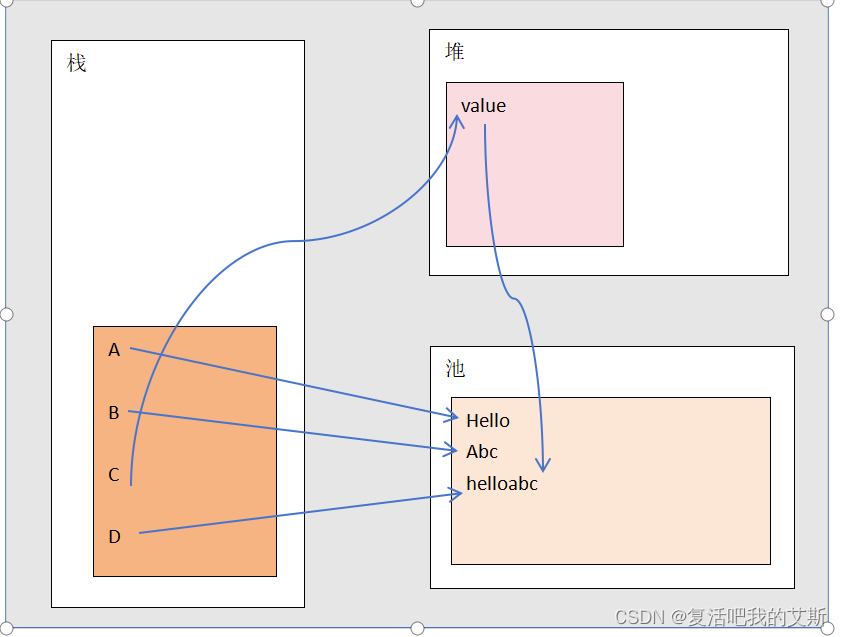
断点查看上面的执行过程

(9).
下面代码输出什么,并说明原因
public class g {
public static void main(String[] args) {
String s1 = "qwq";//指向池中的qwq
String s2 = "java";//指向池中的java
String s5 = "qwqjava";//指向池中的qwqjava
String s6 = (s1 + s2).intern();指向池中的qwqjava
System.out.println(s5 == s6);//t
System.out.println(s5.equals(s6));//t
}
}(10).
下面代码输出什么,并说明原因
public class h {
String str = new String("qwq");
final char[] ch = {'j', 'a', 'v', 'a'};
public void change(String str, char ch[]) {
str = "java";
ch[0] = 'h';
}
public static void main(String[] args) {
h ex = new h();
ex.change(ex.str, ex.ch);
System.out.println(ex.str + "and");//qwqand
System.out.println(ex.ch);//hava
}
}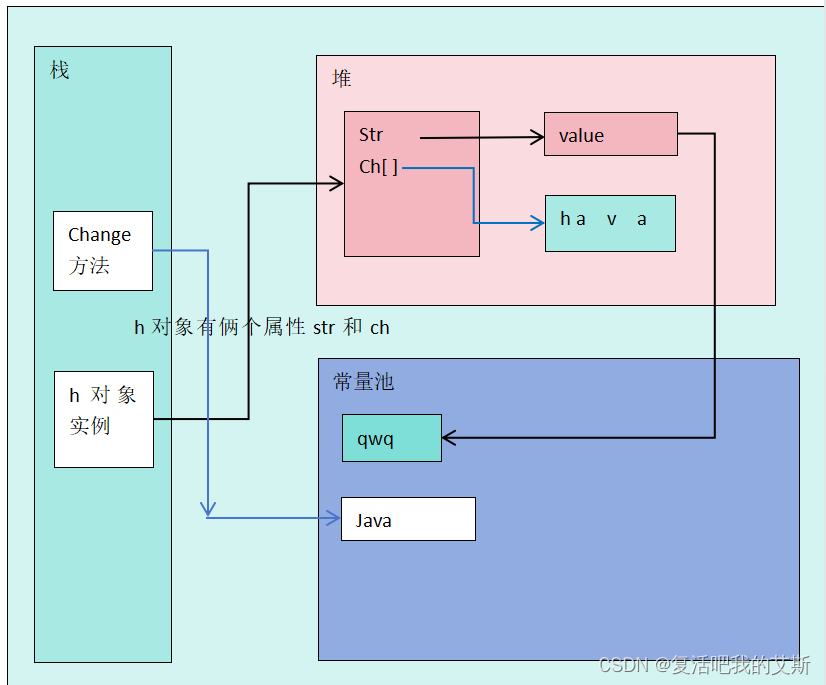
内存分布可以看下面这个链接:
http://t.csdnimg.cn/SinUe
ex.change(ex.str, ex.ch);解读
首先String str=ex.str;把ex的str属性赋给了change方法的str,把ex的ch属性赋给了change方法的ch。
然后,change方法中又把java赋给了str(change方法中的)。
所以,change方法中的str原先指向value,后来指向了常量池的java。
(11).
输出什么
public class lx {
public static void main(String[] args) {
String s=null;
StringBuffer sb = new StringBuffer();
sb.append(s);
System.out.println(sb.length());//4
System.out.println(sb);//null
StringBuffer sb2 = new StringBuffer(sb);
System.out.println(sb2);//null
StringBuffer sb3 = new StringBuffer(s);//报错空指针异常
System.out.println(sb2);
}
}把空字符串追加进去不会报错
(12).
把12345.12变成12,345.12
public class lx2 {
public static void main(String[] args) {
String s1="1234567.12";
StringBuffer sb1 = new StringBuffer(s1);
for (int i = sb1.lastIndexOf(".")-3; i >0 ; i-=3) {
sb1=sb1.insert(i,",");
}
System.out.println(sb1);
}
}(13).
自定义Book类,里面包含name和price。有一个 Book[ ]books = 4书对象。使用前面学习过的传递实现Comparator接口匿名内部类,也称为定制排序。给书排序,可以按照 price (1)从大到小(2)从小到大(3) 按照书名长度从大到小 。
public class c {
public static void main(String[] args) {
Book[] books = new Book[4];
books[0]=new Book("红楼梦",100);
books[1]=new Book("金瓶梅",90);
books[2]=new Book("青年文献",5);
books[3]=new Book("从入门到放弃",300);
//1.price从小到大
Arrays.sort(books, new Comparator() {
@Override
public int compare(Object o1, Object o2) {
Book book1=(Book) o1;
Book book2=(Book) o2;
double priceValue= book2.getPrice()-book1.getPrice();
//double类型的,不符合返回值要求,转变成下面的
if(priceValue>0){
return 1;//改为-1
} else if (priceValue<0) {
return -1;//改为1,变成从小到大
}else {
return 0;
}
}
});
//2.书名长度
// Arrays.sort(books, new Comparator() {
// @Override
// public int compare(Object o1, Object o2) {
// Book book1 = (Book) o1;
// Book book2 = (Book) o2;
// return book2.getName().length() - book1.getName().length();
// //int类型的,符合返回值要求,不用转变
// }
// });
System.out.println(Arrays.toString(books));
}
}
class Book{
private String name;
private double price;
public Book(String name,int price) {
this.name= name;
this.price = price;
}
public Book(String name) {
this.name = name;
}
public String getName() {
return name;
}
public double getPrice() {
return price;
}
public void setName(String name) {
this.name = name;
}
public void setPrice(double price) {
this.price = price;
}
@Override
public String toString() {
return "Book{" +
"name='" + name + '\'' +
", price=" + price +
'}';
}
}(14).
public class e1 {
public static void main(String[] args) {
String str="123456";
try {
str=reverse(str,1,1);
} catch (Exception e) {
System.out.println(e.getMessage());
}
System.out.println(str);
}
public static String reverse(String str,int start,int end){
if(!(str!=null && start>=0 && end>start&&end<str.length())){
throw new RuntimeException("参数错误");
}
char char1[]=str.toCharArray();
char tepm=' ';
for (int i = start,j=end; i<j ; i++,j--) {
tepm=char1[i];
char1[i]=char1[j];
char1[j]=tepm;
}
return new String(char1);
}
}(15).

//1.编写方法userRegister(String name,String pwd,String email)
//2.针对输入内容进行校验
public class e2 {
public static void main(String[] args) {
Scanner sc=new Scanner(System.in);
System.out.println("请输入用户名:");
String s1=sc.next();
System.out.println("请输入密码:");
String s2=sc.next();
System.out.println("请输入邮箱:");
String s3=sc.next();
try {
userGister(s1,s2,s3);
System.out.println("注册成功");
} catch (Exception e) {
System.out.println(e.getMessage());
}
}
public static void userGister(String s1,String s2,String s3){
if(!(s1.length()>=2 && s1.length()<=4) ){
throw new RuntimeException("错误:用户名长度应为2,3,4位");
}
if(!(s2.length()==6 && isDigital(s2) )){
throw new RuntimeException("错误:密码应该是6位数字");
}
int i=s3.indexOf('@');
int j=s3.indexOf('.');
if(!(i>0 && j>i)){
throw new RuntimeException("错误:@开始,且有.");
}
}
//判断是否全是数字
public static boolean isDigital(String s2) {
char[] chars = s2.toCharArray();
for (int i = 0; i < chars.length; i++) {
if (chars[i] < '0' || chars[i] > '9') {//askm值比较
return false;
}//里面这个循环都没有返回false,则就是正确的
}
return true;
}
}(16).

public class e4 {
public static void main(String[] args) {
String s="aa";
printName(s);
}
public static void printName(String s){
if(s==null){
System.out.println("s 不能为空");
return;
}
String[] name=s.split(" ");//按空格分割,存储到字符串数组中
if (name.length!=3){
System.out.println("输入的字符格式不对");
return;
}
String format=String.format("%s,%s,%c",name[2],name[0],name[3].toUpperCase().charAt(0));
//charAt(0)返回0位置的字符
System.out.println(format);
}
}(17).
统计字符串中有几个大学字母,小写字母,数字
public class e5 {
public static void main(String[] args) {
String s="ssAA123";
count(s);
}
public static void count(String s){
if(s==null){
System.out.println("0");
}
int numCount=0,lowCount=0,supCount=0;
int m=s.length();
for (int i = 0; i < m; i++) {
if (s.charAt(i)>='0' && s.charAt(i)<='9'){
numCount++;
}
if (s.charAt(i)>='a'&& s.charAt(i)<='z'){
lowCount++;
}
if (s.charAt(i)>='A'&& s.charAt(i)<='Z'){
supCount++;
}
}
System.out.println(numCount);
System.out.println(lowCount);
System.out.println(supCount);
}
}(18).


(1).equals方法没有重写,还是比较对象
(2)."hello"+s1,会先在堆中创建一个StringBuilder对象,然后指向Hellohsp
(3).t1.inster()指的是堆中的地址。









